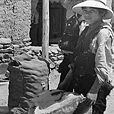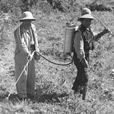Cornell - Peru Project
The Impact of the Vicos Experiment

 The introduction of improved potato seeds and a credit program stimulated the commercialization of
production and generated capital with which the community made a down payment for the hacienda in 1962 after four years
of negotiations. At one point the landed elite who controlled the hacienda raised the price 900 percent. Only after
Edward Kennedy intervened with the President of Peru, Manuel Prado, was Vicos transferred to the community for a price
of two million soles in June of 1962.2 Seven years later, in 1969, the hacienda
system was abolished and a massive agrarian reform put into effect. Even though Vicos was saddled with a debt for the
hacienda, they are nevertheless proud that they were the first to own their land. The Vicos experiment must be put into
historical perspective. Avila (2000:425) provides a chronology of peasant land movements that began in the early 1950's
and peaked at 350 land takeovers in 1962 culminating in the agrarian reform (1969-1975) of the Velasco government. After
1975, the Bermúdez government began to dismantle the state centers of production established during the agrarian reform.
Avila argues that the final death toll for collectivization came at the hands of peasants themselves aided by the
violence generated by Shining Path in the 1980's. Erique Mayer (2002), especially chapters 8 and 9, provides an
excellent discussion of the complexities of land tenure in the Andes and argues that land use practices determine land
tenure. He points out that in the highlands of Peru, the expropriated haciendas have dissolved into peasant communities
(Mayer 2002:324). He suggests that we need to study whether the natural resources of communally held lands are better
managed than privately held lands and Vicos provides an interesting case study for these considerations. Doughty states
(2004) that in 1996, agricultural lands were privatized and distributed with each family belonging to the peasant
community (3700 people in 660 families) receiving about 6.5 acres. But The Mountain Institutes and Urpillachay's recent
research has determined that privatization is not the correct term to use. Land has been distributed but families have
usufruct rights to land for agricultural and herding purposes. Land cannot be sold and therefore is not privatized.
Mayer (2002:255) argues that:
The introduction of improved potato seeds and a credit program stimulated the commercialization of
production and generated capital with which the community made a down payment for the hacienda in 1962 after four years
of negotiations. At one point the landed elite who controlled the hacienda raised the price 900 percent. Only after
Edward Kennedy intervened with the President of Peru, Manuel Prado, was Vicos transferred to the community for a price
of two million soles in June of 1962.2 Seven years later, in 1969, the hacienda
system was abolished and a massive agrarian reform put into effect. Even though Vicos was saddled with a debt for the
hacienda, they are nevertheless proud that they were the first to own their land. The Vicos experiment must be put into
historical perspective. Avila (2000:425) provides a chronology of peasant land movements that began in the early 1950's
and peaked at 350 land takeovers in 1962 culminating in the agrarian reform (1969-1975) of the Velasco government. After
1975, the Bermúdez government began to dismantle the state centers of production established during the agrarian reform.
Avila argues that the final death toll for collectivization came at the hands of peasants themselves aided by the
violence generated by Shining Path in the 1980's. Erique Mayer (2002), especially chapters 8 and 9, provides an
excellent discussion of the complexities of land tenure in the Andes and argues that land use practices determine land
tenure. He points out that in the highlands of Peru, the expropriated haciendas have dissolved into peasant communities
(Mayer 2002:324). He suggests that we need to study whether the natural resources of communally held lands are better
managed than privately held lands and Vicos provides an interesting case study for these considerations. Doughty states
(2004) that in 1996, agricultural lands were privatized and distributed with each family belonging to the peasant
community (3700 people in 660 families) receiving about 6.5 acres. But The Mountain Institutes and Urpillachay's recent
research has determined that privatization is not the correct term to use. Land has been distributed but families have
usufruct rights to land for agricultural and herding purposes. Land cannot be sold and therefore is not privatized.
Mayer (2002:255) argues that:
"Land Tenure must be carefully be defined to avoid falling into the
trap of
ready-made categories such as communal or private property. I see land tenure as a bundle of rights and obligation
heldby different groups and actors over diverse privileges concerning land. The focus here I to ask who has the right to
use what portions of land for specific productive purposes, rather than who has rights over land as
property."